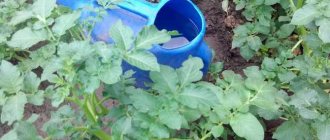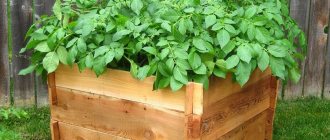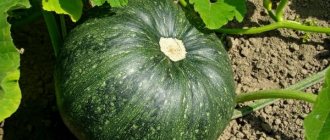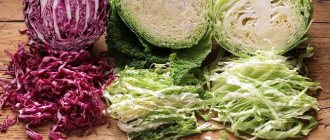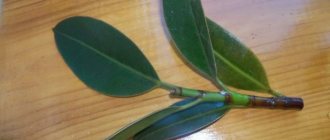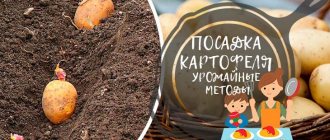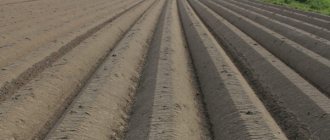What is herbicide
Herbicides are the collective name for chemicals intended to kill plant pests. The scope of their application is very wide - from industrial construction to the purification of water bodies. However, they are most fully used in agriculture.
Treatment with herbicides will rid potatoes of weeds
Based on the nature of damage to harmful vegetation, drugs are divided into two large subgroups:
- Internal action (systemic) – affects the entire weed plant.
- External action (contact) - are not absorbed by the root system of the weed plant, but affect its above-ground part.
The effectiveness of different types of herbicides also varies. Thus, contact varieties, with rare exceptions, are used to control annual pests. But for more complex root systems of perennial weeds, internal chemicals are indispensable - they are able to kill the entire plant and reduce soil overgrowth in the next season. Often herbicides of different types are used together.
Herbicides and their relevance for summer residents
Herbicides are potent chemical-based agents used to control weeds. Their use is especially relevant in large potato fields, although they are no less productive for garden plots, especially if it is not possible to deal with weeds in any other way.
Quite often, perennial weeds with a branched root complex arise and develop on the site, weeding of which does not give the required result, being highly labor-intensive - even a small piece of the root remaining in the ground is enough for the weeds to grow again soon.
In addition, weeds often provide an excellent base for overwintering and subsequent reproduction of microorganisms that are part of the pathogenic group, whose impact on potatoes can cause a range of serious diseases, including late blight.
When weeding young potato bushes, the likelihood of mechanical damage to the still fragile root system increases significantly, which entails the death of the entire bush.
Herbicides for potatoes help to solve all these problems, thanks to which not a trace of former weeds remains, and the harvest pleases the owner with its abundance and quality.
Kinds
The preparations also differ in the range of vegetation affected . This is very important to take into account when choosing chemicals, since an unsuitable product can destroy potato plants along with weeds.
The Russian Ministry of Health annually publishes a list of “Pesticides and agrochemicals” approved for use.
Continuous action
This type of herbicide is the most deadly and is intended to destroy all types of plants in the treated area, without exception . Also in agriculture they are called general exterminators, and they fully correspond to their formidable name.
A continuous herbicide will destroy the protective shell of seedlings, which leads to the death of the future plant
In agriculture, chemicals of this type have a rather narrow application - preparing virgin soil for planting, when it is necessary to remove all biological components from it without exception. It is not easy to find applications for them in gardens ; sometimes they are used for cultivating beds in the off-season.
Selective action
The vast majority of weed poisons are substances with a selective or selective spectrum of damage. They are poisonous only for some types of plants, while remaining harmless for horticultural crops. In turn, they are also divided into two types :
- Broadly selective - they fight certain types of flora, for example, all dicotyledons, without touching monocotyledons.
- Narrowly selective - they do not affect entire plant species, but individual varieties within species; for example, Grodil fights bedstraw, but does not touch related barley and other cereals.
The use of herbicides reduces the number of inter-row treatments of potatoes.
In fact, in home gardens almost exclusively selective preparations are used, which is why we will pay special attention to them.
Pre-emergence
Also known as soil remedies. Their operating principle is clear from the name – it is necessary to treat the soil itself. In addition to penetrating the weed tissue, some types of pre-emergent chemicals leave a thin film on the surface of the soil. Pests are defeated when their sprouts come into contact with it.
Popular pre-emergence products:
- Roundup – contains glyphosates; soil cultivation occurs half a month before planting potatoes; sprouts and roots of weeds are affected.
- Centurion is a pre-emergence herbicide used to control monocotyledonous weeds, such as cereals; saturated with clethodim, absorbed by the root system of weeds, leading to rapid withering of sprouts.
- Boxer - effective against all types of pest flora, especially often used for breeding dicotyledons; its active ingredient is prosulfocarb.
Boxer
Roundup
Centurion
Post-emergence
Also called leaf preparations, that is, they affect the upper, above-ground parts of plants. Most of them use phosphates as the active ingredient.
Popular products used after germination:
- Shogun – used against cereal pests; saturated with propaquizafop, applied by spraying in the most active phase of the weed growing season - the formation of 4 leaves, the stem height is 10 cm.
- Alpha Maize – effective against dicotyledonous plants; destroys weeds within 3-10 days after tillage.
- Tornado 500 – saturated with glyphosates, poisonous to all types of dicotyledonous and monocotyledonous plants; the beneficial effect of the drug lasts up to 30 days, regardless of the weather.
Alpha Mais
Tornado 500
Shogun
Handling post-emergence herbicides is less demanding on the tillage process. So, in the case of their use, there are no strict dosage requirements. Even with a lower concentration of drugs per square meter of area, a beneficial effect occurs , but is not expressed in the complete destruction of weeds, but in a decrease in their germination and ability to form seeds.
In 2021, the Russian Ministry of Health approved 291 herbicides for use in countries.
Traditional methods of weed control
Long before the advent of herbicides for potatoes, gardeners used simple and proven means of combating harmful plants. There are many of them.
Preventive measures
Weed seeds enter the area within the compost or manure. To prevent this you need to follow several rules:
- Do not spread fresh manure around the garden.
- Do not use wheatgrass roots or seeded quinoa to create a compost pile.
- Before adding pulled woodlice to the compost heap, it must be kept in the sun until completely dry. To speed up the process, you can spread the weed on a metal sheet.
Weeds can bring considerable benefits if fertilizer is prepared from them. So, after burning wheatgrass roots, ash is formed, which is useful for potatoes. Quinoa and woodlice can be infused in water for several weeks and used as liquid fertilizer for potatoes, first diluted with water.
Mechanical method
Digging up the site in the autumn season helps in eradicating weeds. After digging, the roots of harmful plants are removed from the soil. But with a shovel you can cut the root system of herbs such as thistle, horsetail and wheatgrass. The small roots remaining in the soil can give rise to new growth. To avoid this, it is best to use a fork or a Tornado cultivator (with twisted teeth) to dig up the soil.
For the same reasons, for weeding and hilling it is better to use not a hoe, but a two-horned hoe or a flat cutter. You need to weed potatoes twice a season: when the sprouts are two to four centimeters in height and when they grow to twenty to thirty centimeters.
Careful weeding and subsequent hilling, during which all weeds are removed, helps to almost forget about them until harvest.
Application of mulching and covering materials
When using raised beds to grow potatoes, weeds will grow between the rows. Even early in the spring, you can pour a layer of fresh straw or sawdust (eight to ten centimeters) into them.
Under the influence of moisture, sawdust or straw will rot, which will lead to an increase in temperature and overheating of the grass under the mulch. This simple method will help save the time spent on frequent weeding.
After the potatoes are dug, dig up the garden. Then the mulch will become a wonderful fertilizer rich in nitrogen.
There is another way to avoid weeding. After the crop is harvested, the ground must be covered with a dark polyethylene film. Neither moisture nor air passes through it. The temperature rises under the film, which leads to overheating of harmful plants that compete with potatoes. In the last days of September and October, all you need to do is remove the film and dig up the garden. For more effective control, after harvesting, water the weeds with boiled water. This way you can destroy not only harmful vegetation, but also microscopic organisms that cause disease. Those weeds that remain after this will die under the film and become feeding for the potatoes.
When the snow melts and spring comes, spread the film on the ground again for three or four weeks. This will lead to overheating of the young weeds. Before planting the tubers, remove the film and proceed to digging up the soil.
There is a method that allows you to practically forget about weeding - using a covering material: black agro-fabric or corrugated cardboard. Potato tubers are planted under the material. Holes are made in it at the place where the holes will be located. After the tubers are planted, all free soil will be under the covering material. No unnecessary plants will be able to grow there, and you can forget about weeding.
Progressive agricultural technologies
Try to sow your plot with useful crops so that it never remains empty. Then the weeds simply won’t have room to grow. After harvesting the potatoes, you can sow the garden with rye grains. The secretions of its roots are a wonderful means for disinfecting the soil. They suppress the development of microbes that overwinter in the ground and cause diseases in vegetables. In addition, rye suppresses the growth of weeds.
In the fall, sow the garden with rye along with oats, and in the spring, dig it up before planting the tubers. Then the sprouted potatoes will be much easier to weed. Mustard is another plant useful for farmers. It suppresses the growth of ragweed and fertilizes the soil.
Green manure plants are called green fertilizers. They are specially planted in order to restore the soil after the growth of vegetables, enrich it with nitrogen and microelements, and also suppress the development of weeds. Green manure is one of the most important components of farming without the use of chemicals.
What can you do if broomrape grows on your property? After the snow has melted from the ground, it is worth sowing the seeds of clover, sunflower or another crop on the roots of which this parasitic plant settles. The broomrape seeds will sprout together. Before it blooms, infected plants are mowed down, and the roots are collected and thrown into the fire. This way the area becomes free from broomrape and ready for planting potato tubers.
Extermination of weeds with alcohol
US scientists have found an original solution to destroy harmful plants.
Add 0.6 liters of alcohol or 1.5 liters of vodka to 10 liters of water. Moonshine will also work. At the beginning of spring, the garden is sprayed with the solution. The volume of the prepared mixture is enough to process two hundred square meters. When exposed to alcohol, weeds will grow rapidly. Even seeds that could lie in the ground without activity for many months will germinate. After this, the farmer only needs to weed the garden and remove all the weeds. Even next season there will be less unnecessary vegetation on such land than usual.
Using Vinegar
Vinegar is an effective weed killer that is safe for people, pets, soil, garden and vegetable crops. It is capable of destroying almost any weed. To prepare the product, vinegar (40%) is diluted with water in a 1:1 ratio.
The vinegar solution can destroy not only harmful but also cultivated plants.
For processing it is best to use a spray bottle. This method is very suitable for areas with a lot of weeds.
The treatment is carried out on a day when the sun is shining brightly and no strong wind is blowing. The absence of powerful air currents will not allow the acidic composition to enter the crops and cause them harm. The sun's rays make the composition even more active. The mixture can also be used selectively if you use a brush. After two days you can see the result. For those weeds that are in no hurry to die, the treatment is repeated.
Vinegar should be used when the weeds have not yet begun to form seeds. The best period for this is early spring. Perennial harmful grasses should be treated in the fall. At this time, vinegar, having got through the leaves, will penetrate deep into the weed, reach its root system and destroy it.
Combination of vinegar and salt
This is a very caustic mixture. For the composition you will need:
- Water - one liter.
- Table vinegar - five tablespoons.
- Salt - two tablespoons.
Water is boiled, after which salt and vinegar are added to it. The composition is thoroughly mixed and poured hot onto the weeds.
Herbicidal soap
To prepare it take:
- White vinegar - one liter.
- Salt - one hundred and fifty grams.
- Liquid soap - one to two tablespoons.
Pour salt into a bottle, fill it with vinegar and add soap. Shake the mixture and pour it onto the weeds so that it does not fall under the beneficial plants.
Weeds can cause a lot of trouble for any farmer who wants to grow a lot of potatoes. However, judicious use of herbicides will make gardening much easier. There is no need to rush to use them. First of all, try to defeat weeds using folk methods. The use of weed killers will be especially useful for those who do not have enough energy and time to constantly weed potato beds. This way you can get a high-quality and rich harvest of your favorite vegetable.
The most popular herbicides for potatoes
The modern market is extremely saturated with drugs of various effects. But even among the existing herbicides , there are several that are most loved by gardeners due to their ease of use and effectiveness. What preparation should I choose for processing potatoes?
Zenkor
Zenkor
Refers to selective herbicides, completely harmless for nightshades, carrots, and potatoes. The chemical is based on the substance metribuzin , which breaks down in the soil no faster than 3 months after treatment. The use of Zenkor is especially beneficial for the control of broad-leaved and cereal plants.
Zencor is supplied in both liquid and granule form.
An important advantage of Zenkor is its saturation with the active substance - 600 g/l. In addition to damaging the sprouts, after application it leaves a protective film on the surface of the bed . Works great in mixtures as it is compatible with a wide range of insecticides and pesticides.
Titus
Titus
Has a selective effect; spraying should be done in the post-emergence period. The active ingredient is rimsulfuron, which blocks the process of acetolactosynthesis in the leaves. Equally effective against annual and biennial plants . The first signs of weed death are noticeable within 3 days, and their complete death occurs no later than 15 days after treatment.
Titus is suitable for preparing tank mixtures, but is incompatible with phosphorus insecticides. It is very demanding on humidity - in case of prolonged drought, the consumption of the chemical should be increased. May cause temporary yellowing of potato leaves. Not recommended for use on seed bushes.
Lapis lazuli
Lapis Lazuli
Lazuli is a universal product used for both pre-emergence and post-emergence treatment of beds. The principle of action is similar to Zenkor - the main substance is also metribuzin (700 g/l).
One of the most powerful preparations, it is used strictly once per season , only in exceptional cases is double treatment allowed - before germination and after, when the potato sprouts have reached a height of 10 cm or more. Lapis lazuli should be handled very carefully - contact with skin, mucous membranes, eyes or food can worsen a person’s well-being.
Processing methods and times
To destroy weeds with potato herbicides, any of the existing spraying methods can be used:
- ordinary;
- fine-droplet;
- large-drop;
- aerosol.
It is not recommended to spray preparations during dry periods and during windy conditions. It is forbidden to exceed the dose so as not to harm the seedlings, otherwise the excess will flow off. To apply the drug, special equipment is used, for example, ground sprayer trailers. The optimal pressure for uniform spraying is considered to be a pressure in the equipment of up to 1.5 atmospheres; a special spray tip is needed.
If the weed vegetation has grown too dense on the site, treatment is carried out with continuous action chemicals in the spring during planting or before seedlings appear, and in the fall. After the potatoes sprout the first shoots, it is allowed to use herbicides that have a selective effect on the cultivated field.
A day or three before work, the soil should be watered; it should be slightly moist. They are treated on the same day, morning and evening; nothing can be done on the site for 14 days. During this period of time, the composition will penetrate the soil and begin to destroy weeds. On average, 5 liters of solution will be needed per hundred square meters of land. When choosing herbicides, it is necessary to take into account the extent to which the potato field is overgrown with unnecessary grass.
Consumption rates
Different manufacturers recommend their own consumption rates for herbicides, but the dilution method is similar, on average 40-80 ml per 10 liters of water. If weed plants have powerful and strong roots, you can add 100-120 ml of the product. For clayey and heavy soil, the concentration should be maximum. If the soil contains a lot of manure - minimal. After dilution, the solution is ready for use. More details are described in the instructions for use. When treating a potato field with herbicides, be sure to wear a respirator, goggles and gloves.
Contraindications for use
If there are insects or signs of disease on the potato bushes, the use of herbicides is prohibited. If this advice is not heeded, spraying will lead to the death of the plant. It is not advisable to use chemicals for small numbers of weeds. You need to keep in mind that there are potato varieties that are sensitive to herbicides, so before growing it is recommended to find out how the selected variety relates to chemical treatment.
Natalia. Samara:
If earlier I pulled out weeds with my hands, now I started using herbicides. It was especially difficult to fight bindweed; it constantly grew back. Right now I'm using Lapis Lazuli. I am very pleased with the results of the treatment.
Evgeniy, Barnaul:
From the very beginning of growing potatoes, we could not get rid of weeds in the field. After trying many methods and preparations, we purchased the herbicide Zenkor. Now we fight weeds exclusively with this type of drug. Quick effect and ease of use are guaranteed.
Using herbicides on potatoes helps control nuisance weeds. If you use them within reasonable limits, there will be much less work in the garden, but there is no need to rush to use them. It is best to first try to deal with weeds using known folk methods or manually. The herbicide should be selected wisely; the yield depends on it. If you have no experience, you should consult a specialist. He will help you choose the type of herbicide and calculate the dosage.
How are weed killers used?
The effectiveness of soil chemicals is extremely dependent on the gardener's compliance with a number of requirements for their use.:
- uniform soil structure - large lumps of earth that prevent the uniform distribution of the substance over the surface are not welcome;
- humidity – it is advisable to moisten the soil before using herbicides;
- depth of embedment in the ground - no deeper than 5 cm;
- type of soil - the activity of the drugs will be lower in fertile soils, the humus saturation of which exceeds 5%; preparations are more suitable for sandstones and other types of light soils;
- heat level – when the air temperature is less than 5°C, performance decreases.
It is also important to keep in mind that with rotational farming—rotating crops in a garden bed each year—chemicals may prevent some types of vegetables from growing properly. Before using herbicides, be sure to study the list of incompatible crops.
Types of herbicides
Substances for exterminating weeds vary in terms of their use. They are used:
- Before planting tubers.
- During and after planting, before emergence.
- During the growing season, after emergence.
When choosing a herbicide, consider how many weeds are present in the garden bed. If there are too many of them, use continuous action preparations to destroy all unnecessary vegetation. They are used before sprouts appear in spring and autumn and during planting. Such means include: Gesagard, Arsenal, Zenkor and others.
After germination, selective agents are used that affect only weeds: Lapis Lazuli, Antisapa, Titus.
Effect of herbicide treatment of potatoes
The mechanism of action of different types of herbicides is different. It depends on their chemical composition and method of application. Based on how the chemical appears on plants, the following varieties can be distinguished :
- Destroy cell membranes - lead to drying of weed sprouts; the effect begins to appear immediately after treatment.
- Hormone replacement is the mechanism of action of benzoic or acid herbicides; destroys the connections of leaf tissues; the effect is weakly manifested in relation to grain varieties of weeds.
- Suppression of photosynthesis - only against dicotyledonous weeds.
- Suppression of the ability of cells to divide - chemicals of this type are classified as chloroacetamides; the effect is gradual, first the plant weakens, then dies.
- Suppression of amino acid synthesis leads to stopping the development of the weed.
- Suppression of fat synthesis - immediate cessation of development, drying out of the plant within 15 days.
The use of herbicides can completely eliminate the transfer of viruses, which is provoked by damage to the bushes
. Unfortunately, the effect of the use of herbicides is partially manifested on potatoes, especially if the dosage or processing procedure is incorrect . To minimize it, you can supplement or partially replace chemicals with less aggressive substances.
Some types of weeds may become addicted to the active ingredients of chemicals. Therefore, you should not use exclusively one type of preparation - replace the herbicide with another at least once every 3-5 seasons.
Application technique and additional tips
When using herbicides on tomatoes and potatoes, everyone should wear a protective suit.
Despite the fact that the substances themselves are low-toxic, it is recommended to refrain from smoking both during and after treatment:
- On the packaging, the manufacturers themselves give recommendations on how to prepare the composition.
- There is no universal formula for everyone. It is necessary to take into account potato varieties, weather conditions and types of weeds, and the nature of the soil.
Note. Some varieties are not able to withstand chemical treatment at all. After this, they may lose their taste.
Other products in addition to herbicides
Herbicides are not able to provide complete protection against all hazards. Depending on the threat, potatoes and other crops can be treated with the following types of preparations :
- Fungicides – to combat fungal spores.
- Insecticides are chemicals that kill parasitic insects.
- Acaricides – against mite infestation of plants.
- Bactericides – prevent the proliferation of microorganisms.
- Nematicides – against nematode worms.
- Folk remedies - from kerosene to copper sulfate.
Finally, a conventional analogue of chemicals is hand weeding. But even with the most thorough removal of weeds, the effect will not be comparable to that after treatment with special means. Therefore, herbicides remain in demand among gardeners , who prioritize a rich harvest.
Popular and effective means
According to the timing of use, weed control preparations can be divided into pre-emergence, post-emergence and those that are used regardless of the stage of development of the crop plant.
Pre-emergence
Herbicides for potatoes that are used on weeds before the potatoes have emerged, or before they are planted, are called pre-emergence or soil-based. They are introduced into the ground during irrigation or in dry form. Preventing the appearance of weeds for a long time is the main advantage of this type of weed control. Several types of these drugs are widely known.
Growth regulators for pre-planting treatment of potatoes
Treatment with growth regulators (biostimulants or phytoharmones) allows you to stimulate the onset of growth processes and accelerate development by activating natural biological processes, thereby increasing the plant's immunity.
This also, but only indirectly, provides protection for potatoes from pests and diseases - a strong plant is able to withstand unfavorable factors and pests. Among the drugs in demand in practice are Epin, Zircon, Energen, Bioglobin, Poteytin, etc.
| More details: “Epin” / “Zircon” - which one to choose and how to use (comparative analysis) |
How to remove field bindweed?
One of the most dangerous weeds for the development of tops after germination is field bindweed (birch). It is often found in glades and meadows of the middle temperate climate.
The danger of the weed is that it not only destroys potatoes after the first shoots, but also causes enormous damage to the soil. Also, during the active growing season, the weed plant inhibits the development of the foliage system and the bush as a whole. As a result of this, the loss of yield is measured in a 30% ratio. This plant is resistant to docile conditions. It is able to extract moisture from the soil because its roots go deep into the ground. As a result of this action, the soil dries out completely. Many summer residents ask the question of how to get rid of birch trees in a potato garden?
How to remove bindweed from a potato field forever and without much expense? The main root goes into the soil to a depth of 6 m, and in horizontal directions there are shoots of 30 cm. To remove the plant from the soil forever, it is necessary to use herbicides - Tornado, Hurricane, Roundup. Preparing the solution is very simple. Only add 40 to 120 ml to a container of clean water (10 liters). herbicide. You need to spray the weed leaves directly twice a day (early morning and evening). After using the drug, you must not water the potato beds for 3-5 days. It is also not recommended to hill potatoes during this period.
Features of individual drugs
- The mechanism of action is to stop the process of photosynthesis.
- The drug solution is prepared at the rate of 10 g/9 l of water. Consumption – 9 l / 300 m2 (3 acres).
- The protective effect on the soil continues after the death of the weeds. You can start working on the site in a week.
- Release form: powder for dissolution. The concentration of DV (metribuzin) is high – 700 g/1 kg.
- Analogues - Antisapa, Zenkor, Zontran.
- Suitable for tank mixes.
Attention! Not suitable for early ripening varieties (Sante, Fresco, Zhuravinka, Atlant, Zdabytak, Odyssey, Orchid).
- The mechanism of action is to stop the process of cell division.
- Suitable for all potato varieties.
- The height of the tops when sprayed is 5-20 cm.
- The working solution is prepared in the proportion of 5 g/20 l of water; It is recommended to add a solution of Trend 90 adhesive 0.1% (20 ml/20 l of water) to increase the validity period. Spraying can be carried out once or in fractions, but then the concentration of the solution is correspondingly 2 times lower. 20 liters of solution – for about 10 acres.
- Do not apply to wet leaves.
- DV – rimsulfuron 250 g/kg. Release form: dry, flowing suspension (packaging 100 g) or water-soluble granules (packing 500 g).
- Analogues - Tivitus, Ramses, Maytus, Maytus, Tanais.
- Do not use together with organophosphorus insecticides and fertilizers for foliar feeding.
- A two-component drug that penetrates into the thickness of tissues through leaves and roots, suppresses the processes of cell division and photosynthesis.
- Potato varieties sensitive to the drug: Vitesse, Leoni, Innovator, BP 808, Bonus, Excellence, Manitou. Before use, check whether the product is suitable for a particular variety.
- The solution is prepared based on a liquid consumption of 10 l/100 m2: 60 g/10 l of water; this is enough to pollinate 3 acres of plantings.
- After irrigation, the tops may turn slightly yellow and become deformed.
- Release form: water-soluble granules (packages of 5; 10 kg). Composition: b 240 g/kg, metribuzin 175 g/kg.
- When used in tank mixtures, first check the substances for compatibility.
- Mechanism of action: suppression of growth and respiration centers; stopping the synthesis of vital enzymes.
- Working solution – 36 ml/10 l of water (for 3 acres of plantings).
- A slight painful reaction of the crop to spraying is possible.
- Release form – water-soluble concentrate, a mixture of sodium, potassium, dimethylamine salts of MCPA acid 590 g/l.
- Suitable for tank mixes.
- Analogues: 2M-4X, MSRA, Dikopur MCPA, Agroxon, Herbitox, Hvastox.
- The mechanism of action is inhibition of growth centers. Ineffective against dicotyledons.
- Working solution – 30 ml/10 l (for 3 acres of plantings).
- The crops tolerate treatment well.
- Can be used in tank mixtures, but preliminary testing is required.
- Release form – emulsion concentrate containing 40 g/l quizalofop-P-tefuril.
Weeds and potatoes: obvious and hidden dangers
Potatoes are very vulnerable to weeds: 12-25 days pass from planting to germination, during which time the “enemies” have time to emerge and gain strength. By the time potato sprouts appear, the area is already tightly occupied. Weeds pull out the lion's share of nutrients and fertilizers intended for root crops from the soil, shade and entwine young bushes.
A weedy area is a habitat for harmful insects that destroy leaves, flowers, and shoots of potatoes: beetles, mole crickets, aphids, and potato moths. In poorly ventilated spaces, fungal infections develop: late blight, fusarium wilt, powdery mildew.
Harvest loss in this case is up to 80%. Mechanical processing does not always save. Firstly, excessive loosening of the soil is dangerous due to loss of moisture, damage to roots and shoots. Secondly, after a labor-intensive procedure, the parasites quickly come to life. It is especially difficult to cope with them when time is lost and the crop is threatened with death under the onslaught of weeds.
Fungicides for treating potatoes before planting (against diseases)
The source of various potato diseases is phytopathogens (fungi, bacteria, viruses). The pathogens located on the seed tubers are at rest at the time of dressing; therefore, with timely dressing, the longest possible contact between the phytopathogen and the fungicidal sediment is achieved, which ensures effective destruction of the pathogen.
But it is somewhat more difficult to combat soil phytopathogenic fungi, since they not only infect plants during germination, but also penetrate into plant tissues located at a considerable distance from the area of action of the drug.
To inhibit the growth of pathogens, seed tubers are treated with special fungicides (chemical or biological). Among the most used drugs are “Fitosporin”, “Maxim”, “Albit”, “Agat-25K”, “Planriz”, “Sporobacterin”, “Silk”, “Gamair”, etc.
Fungicides provide protection against rhizoctonia, late blight, alternaria, common scab, wet bacterial rot, dry fusarium rot and other diseases.
| " Fitosporin-M " (paste, powder) | Biofungicide based on the bacterium Bacillus subtilis on a humic carrier. Either the universal preparation “Fitosporin-M Universal” (paste) or a special preparation for processing potatoes “Fitosporin-M Instant Potatoes” (paste) is used. For pre-planting treatment, dosage is 100 ml / 2-3 l of water, consumption - 2-3 l / 100 kg of tubers. More information about the drug "Fitosporin-M, Zh, P, PS" | |
| " Maxim ", "Fludimax", "Protect", "Sinclair" (suspension concentrate) | Fungicidal disinfectants based on fludioxonil (25-75 g/l.), chemical class - phenylpyrroles. Dosage – 20-40 ml/1l. water/100kg. More information about the drug "Maxim, KS" | |
| " Albit, TPS " (paste) | The bacterial biological fungicide works as a growth regulator with the properties of a fungicide and a complex fertilizer. First treatment before planting: dosage - 10ml/1l. water, consumption - 1 l./100kg. Second treatment in the phases of tops closing in the beds: dosage -1-2ml. drug/10l. water. Further treatments after 10-14 days. | |
| " Agat-25K " (paste) | Biofungicide with growth-regulating activity based on the bacterium Pseudomonas auerofaciens . The drug activates the plant’s immunity by forming nonspecific systemic resistance to pathogens, and also neutralizes pathogens with a phytotoxic effect. Pre-planting treatment - dosage 15g/1 l. water, consumption - 1l/100kg. The second treatment in the tops closing phase is a dosage of 10g/1 l. water, consumption – 4 l./100m2. Further preventive treatments after 10-14 days. | |
| " TMTD " (aqueous concentrate) | Chemical pesticide used in agricultural production, active ingredient - thiram (400g/l), class dithiocarbamates. Dosage – 40-50g/1 l. water, consumption - 2l/100kg. seed tubers. | |
| «Planriz» | Bacterial biofungicide based on the bacterium Pseudomonas fluorescens . Seed tubers are treated on the day of planting, or no more than 7 days before planting. Dosage 10 ml./10 l. water, consumption rate - 1 l./100 kg. | |
| " Silk " (water emulsion) | Biological product, stimulator of plant growth and development, with powerful immunostimulating and fungicidal properties. | |
| " Gamair " (powder) | Bacterial biofungicide based on the bacterium Bacillus subtilis (bacillus subtilis). Dosage of pre-planting treatment - 2-3 g / 2 l. water, consumption 1 l./up to 500 kg. planting tubers. More information about the drug "Gamair KS, SP, Tab" | |
| " Sporobacterin " (powder) | Biofungicide of complex action. The active ingredients are the bacterium Bacillus subtilis and the fungus Trichoderma viride . Treatment is carried out by spraying, dosage - 4-5g/1 liter. water/120 kg. More information about the drug "Sporobacterin, SP" |

